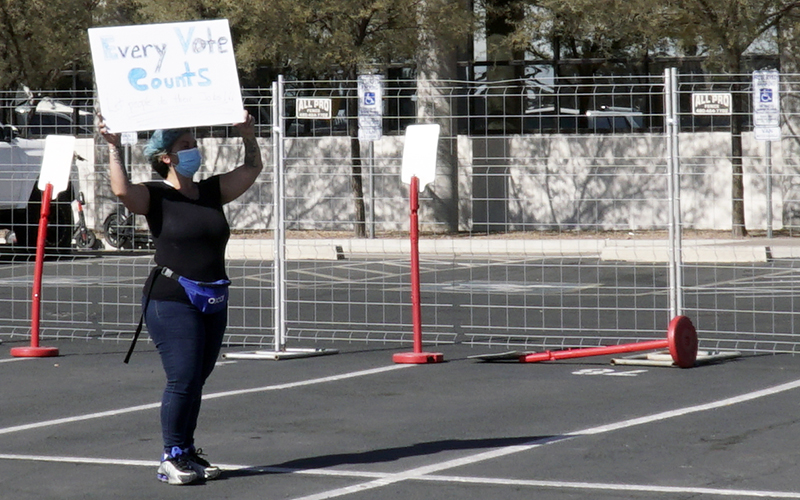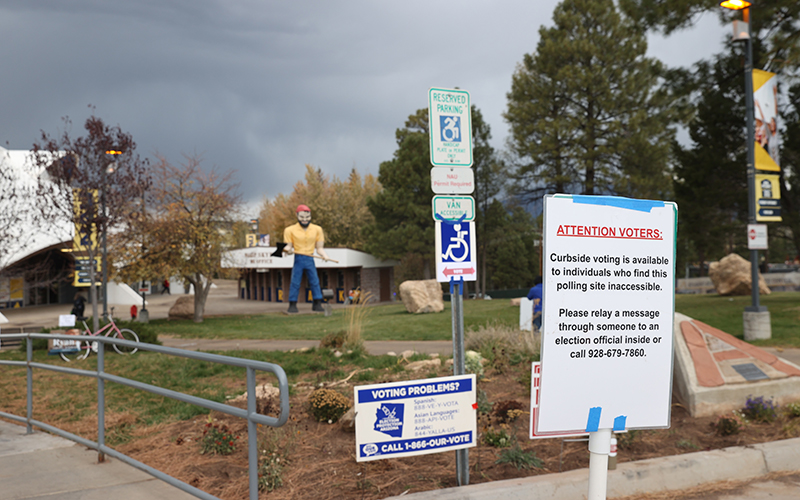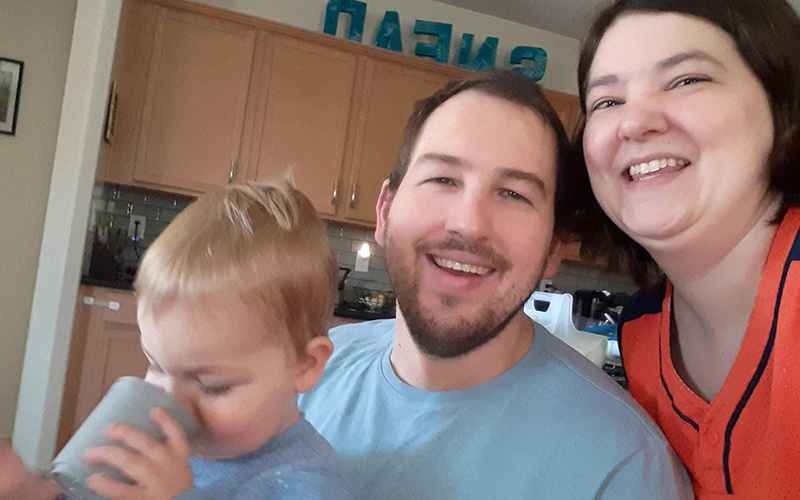- Slug: BC-CNS-Disabilities Voting,970
- 4 photos available (thumbnails, captions below)
By Daja E. Henry
Cronkite News
PHOENIX – As the presidential election hangs in the balance, protests erupt at ballot counting stations and controversies swirl about getting every vote tallied, one group in particular faces significant challenges that can leave them out of the process.
About 38 million people with disabilities, or one-sixth of the electorate, were eligible to vote this year, according to a study by Rutgers University. Yet turnout is historically lower for this group, with physical challenges and a lack of support often standing between them and the ballot box.
During each election, 30-year-old Calvin Cook requests a mail-in ballot and drops it off in person at his precinct. Cook was 6 years old when he was hit by a motorcycle and left partially paralyzed.
“I like to let people see that people with disabilities are voting,” said Cook, president of Youth Action Council of Arizona, an advocacy group for people with disabilities and their allies.
Jason Snead of Phoenix voted this year using a mail-in ballot and the help of his wife. But in previous elections, Snead, who has cerebral palsy, did not have that support.
“(Voting) lets me do something without somebody telling me I can’t do it,” the 37-year-old said. “Many times in my life, people told me …let me make this choice for you because it’s better for me to make this choice for you.
“With voting, I get to make that choice on my own and nobody can tell me any different.”
There are legal protections in place for voters with disabilities. The 1990 Americans with Disabilities Act requires that state and local governments provide full and equal opportunities to vote. The 2002 Help America Vote Act requires polling places to provide at least one accessible machine for voters with disabilities.
But despite these protections, voters and advocates still report barriers to voting.
After the 2016 election, a federal analysis of access to 178 polling places found that
60% had one or more potential impediments for people with disabilities. That included steep ramps, poor parking and lack of signs indicating accessible paths.
In September, the Arizona Center for Disability Law filed a lawsuit against Cochise County on behalf of Sierra Vista resident Kathleen Hoffard, who has physical disabilities that make voting in person difficult, including spinal stenosis and rheumatoid arthritis. She also takes medication to suppress her immune system, which leaves her at higher risk of suffering serious illness from COVID-19.
The lawsuit contended that a county ban on curbside voting could disenfranchise people with disabilities who wanted to vote in person. A federal judge rejected that argument.
The ADA allows for jurisdictions to make reasonable accommodations to their procedures for voters with disabilities. However, what qualifies as a reasonable accommodation can differ from place to place.
Sey In, an attorney in the Cochise lawsuit, said requests for accommodations should be considered on a case-by-case basis, because “every person is different, and every person with disabilities is different.”
With curbside voting in particular, he said: “It’s tricky, because it’s not mandated by state law or federal law.”
If a building is declared ADA accessible, no extra accommodations are required. The Arizona Elections Procedures Manual says curbside voting may be provided if a polling place is deemed inaccessible. Cochise County’s poll worker’s handbook says all of its 17 vote centers are accessible, so “curbside voting is no longer offered as an additional service.”
Elizabeth Pendo, a professor at Saint Louis University School of Law, notes that the federal ADA guidelines are meant to be a starting point.
“To say a building is accessible is great. … But that is a minimum. That is a floor required by federal law (and) doesn’t necessarily mean that people with disabilities have an equal opportunity to vote,” she said.
Beyond barriers at polling places, people with disabilities often rely on help from poll workers, relatives or guardians to cast ballots – help that’s not always readily available or freely given.
And when their vote depends on the assistance of another person, they are not afforded the same confidentiality as voters stepping into booths or sealing their own ballots.
“People with disabilities have to be given an equal opportunity to vote securely and privately, the same as people who don’t have disabilities,” Pendo said.
When George Garcia was just 12, he was paralyzed from the shoulders down because of a spinal tumor. Now 38, Garcia depends on his mother to help him fill out and sign his ballots.
While he has a support system, Garcia said those living in group homes or with guardians may not.
“Even within the support system itself, whether it’s family or people that are providing assistance to a person with an intellectual disability, they often just will assume that either A, the person is not interested in voting or B, does not have the mental capacity to make that kind of decision,” said Garcia, executive director of the Southwest Institute for Families and Children with Special Needs in Phoenix.
Advocates said more education is necessary to combat a mindset that too often leaves those with disabilities powerless.
Cook, Snead and Garcia are all what’s known as self-advocates, those who work to encourage people with disabilities to be involved in decisions made about their lives.
Cook worked with young people with disabilities this election to ensure their votes were counted. Garcia works to educate others on different forms of guardianship and how to choose one that allows involvement by the person with disabilities.
Snead, a researcher for the Arizona Developmental Disabilities Planning Council, went to law school so he could help people like himself. People with disabilities sometimes get too accustomed to others doing things for them, because it happens so much, he said.
“I wish people would presume competency, presume that we can do things,” Snead said, “rather than assume that we can’t do things.”
For more stories from Cronkite News, visit cronkitenews.azpbs.org.
^__=
Calvin Cook, 30, is president of the Youth Action Council of Arizona, an advocacy group for people with disabilities. During each election, he requests a mail-in ballot and drops it off in person at his precinct, but other voters with disabilities can face significant challenges to casting ballots. (Photo courtesy of Calvin Cook)
About 38 million people with disabilities, or one-sixth of the electorate, were eligible to vote this year. Yet turnout is historically lower for this group, with physical challenges and a lack of support often standing between them and the ballot box. (Photo by Franco LaTona/Cronkite News)
At this polling station in Flagstaff, curbside voting was offered on Election Day to those with disabilities who could not otherwise access the site. It was a different situation in Cochise County, Arizona, where a lawsuit asking for curbside voting was rejected this year. (Photo by Luke Simmons/Cronkite News)
Jason Snead, center, with wife Autumn and son Sam. Snead has cerebral palsy, so each election year his wife helps him fill out his ballot. He says voting allows those with disabilities to regain some semblance of control over their lives. “With voting, I get to make that choice on my own and nobody can tell me any different.” (Photo courtesy of Jason Snead)



